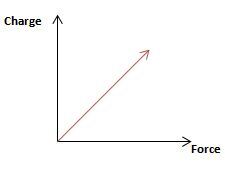Electric charges
In physics, charge, also known as electric charge, electrical charge, or electrostatic charge and symbolized q, is a characteristic of a unit of matter that expresses the extent to which it has more or fewer electrons than protons. In atoms, the electron carries a negative elementary or unit charge; the proton carries a positive charge. The two types of charge are equal and opposite.
The classical study of electricity is generally divided into three general areas.
the study of the forces acting between charges
the study of the forms of energy associated with the flow of charge
the study of the forces acting between charges in motion

Units
The SI unit of quantity of electric charge is the coulomb, which is equivalent to about 6.242×1018 e (e is the charge of a proton). Hence, the charge of an electron is approximately −1.602×10−19 C.
Properties
The properties of electric charges are as follows:
Additivity of electric Charge
Conservation of electric Charge
Quantization of electric Charge
Types of electric charge
There is two kinds of electric charges, positive and negative, If positive and negative charges got identical number than negative and positive charges would cancel out each other and the object would become neutral.
1. Positive Charge(+)
When an object has a positive charge it means that it has more protons than electrons.
2. Negative Charge(-)
When an object has a negative charge it means that it has more electrons than protons.
Methods of charging
The process of supplying the electric charge to an object or losing the electric charge from an object is called charging and can be charged in three different methods as follows:
1. Charging by friction
When the both objects are rubbed against each other, the charge get transfer. One objects loses electrons while other object gains electrons. The object that loses electrons becomes positively charged and the object that gains electrons becomes negatively charged. Both the objects get charged due to friction and this method of charging is commonly known as electrification by friction.
2. Charging by conduction
This is the method of charging an uncharged object by bringing it close to a charged object, it is known as charging by conduction. The charged conductor has an unequal number of protons and electrons therefore when an uncharged conductor is brought near it, it discharges electrons to stabilise itself.
3. Charging by induction
This is the process of charging an uncharged conductor by bringing it near a charged conductor without any physical contact, it is known as charging by induction.
